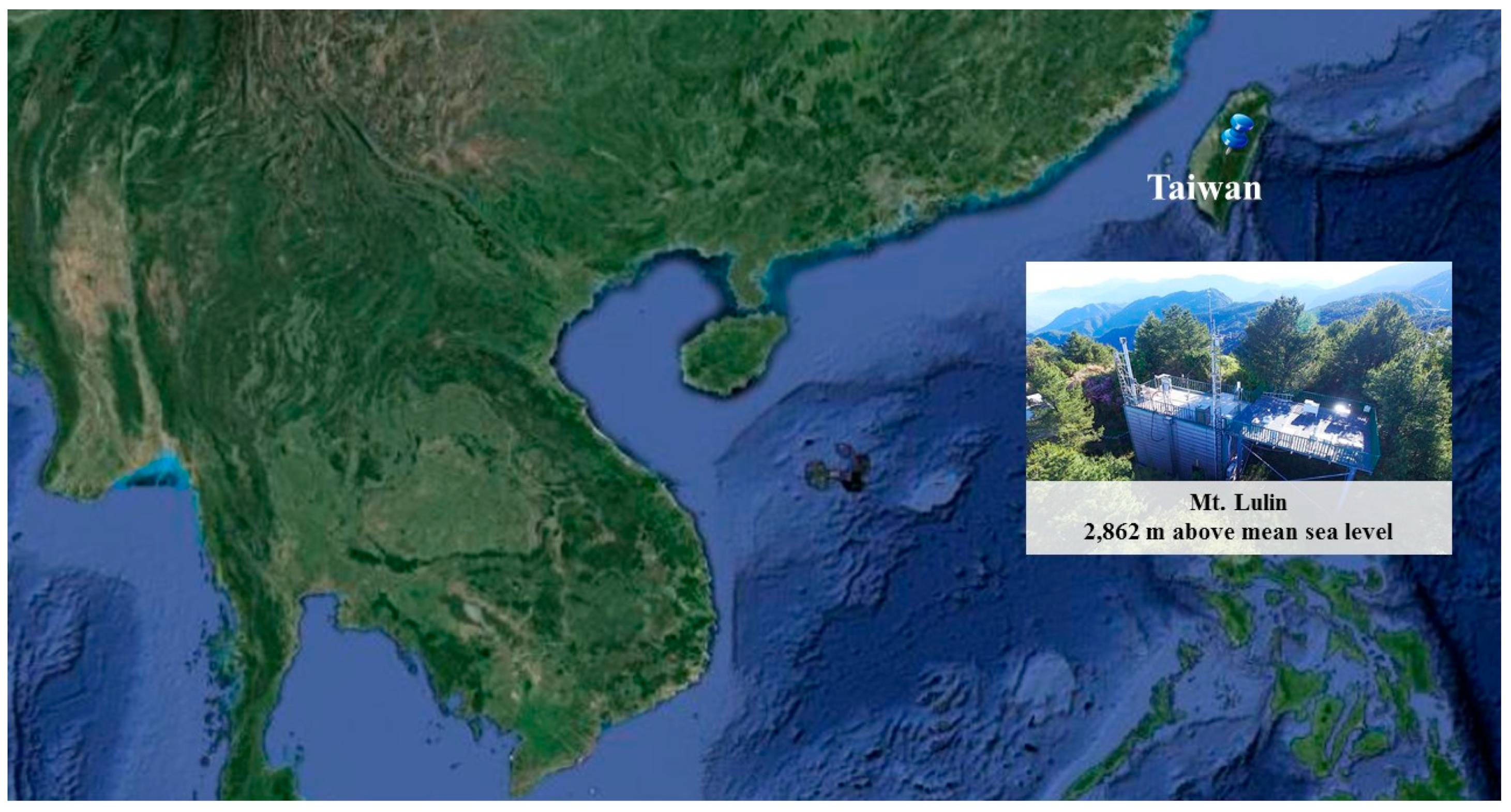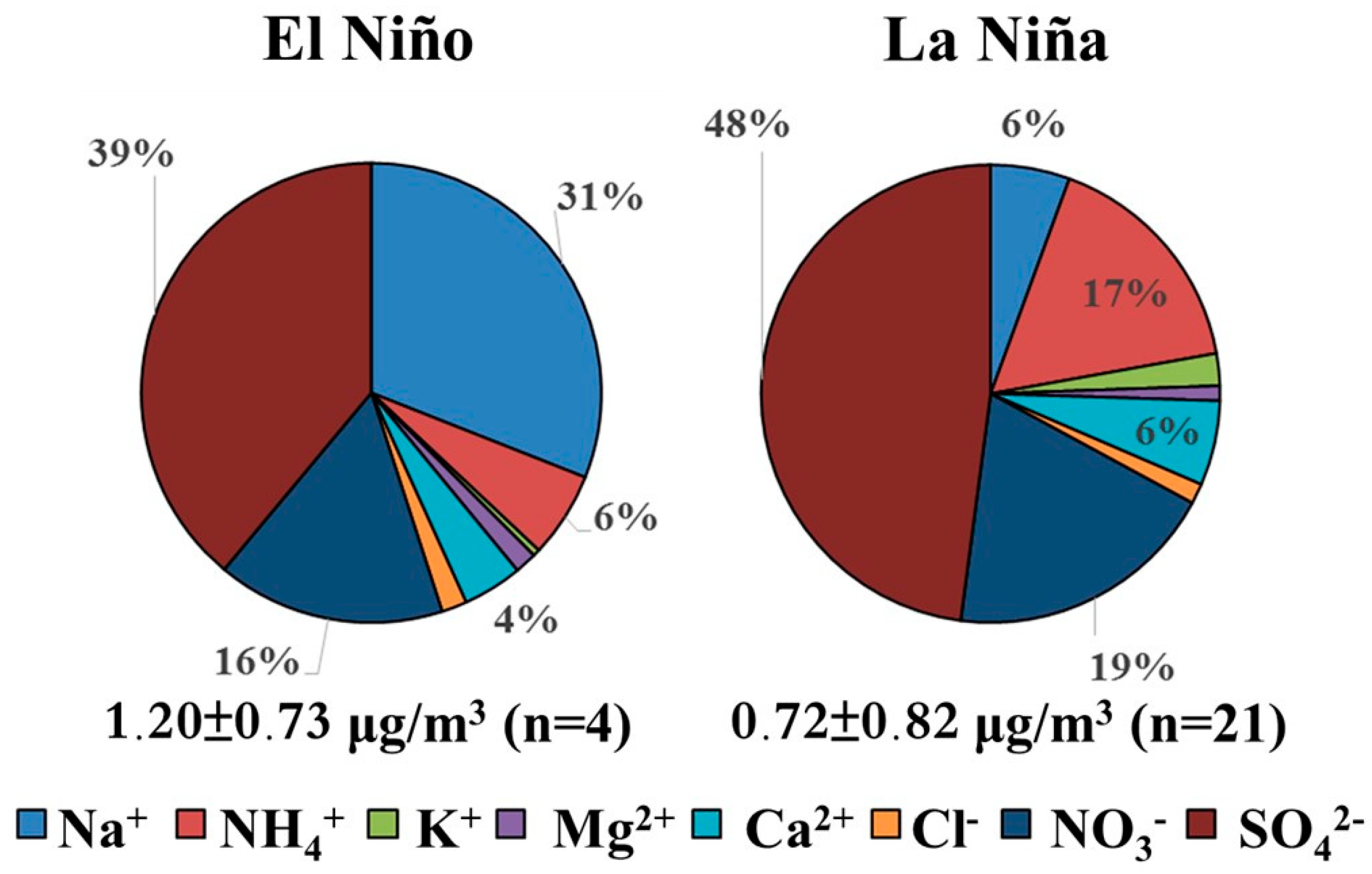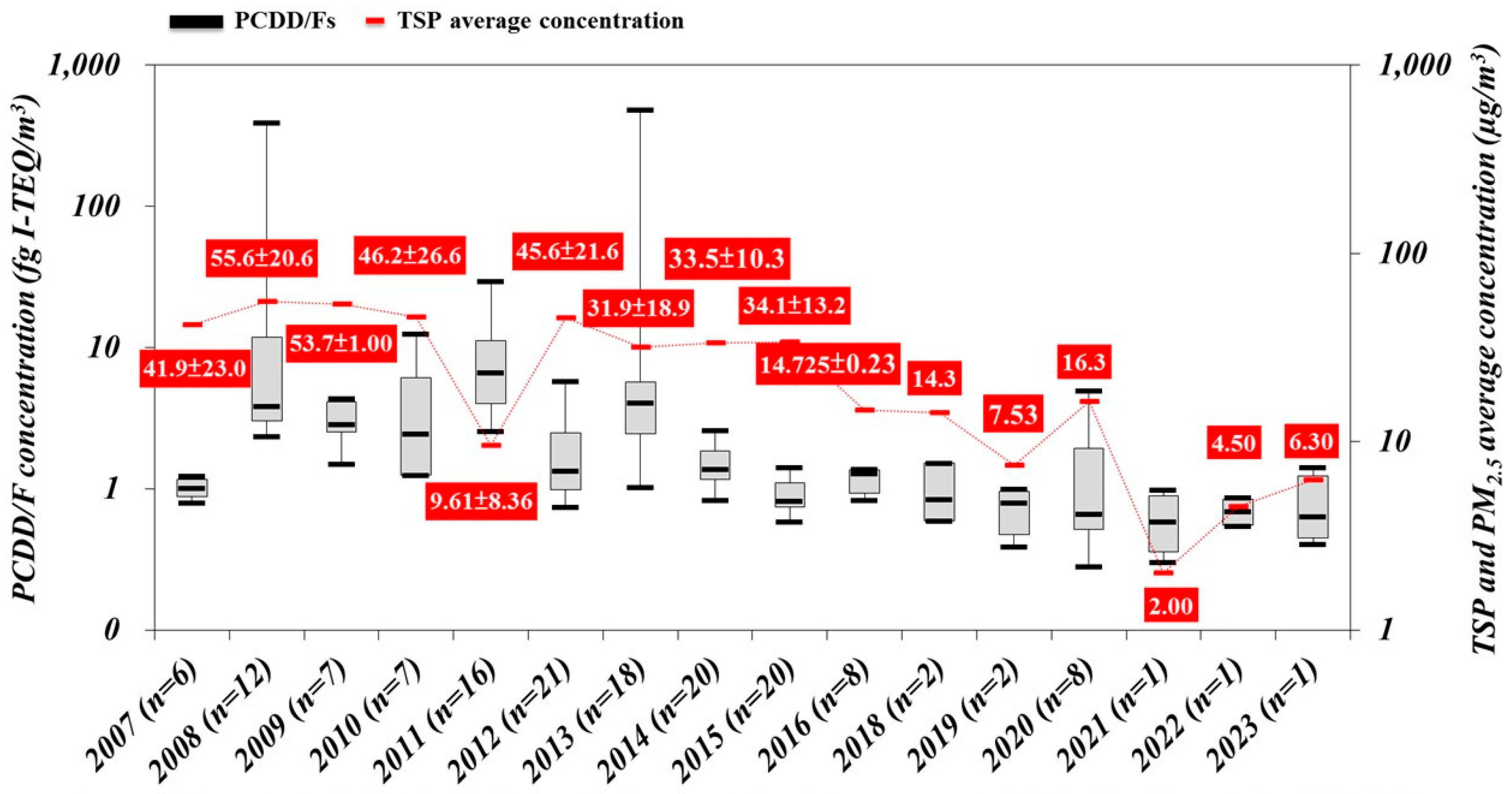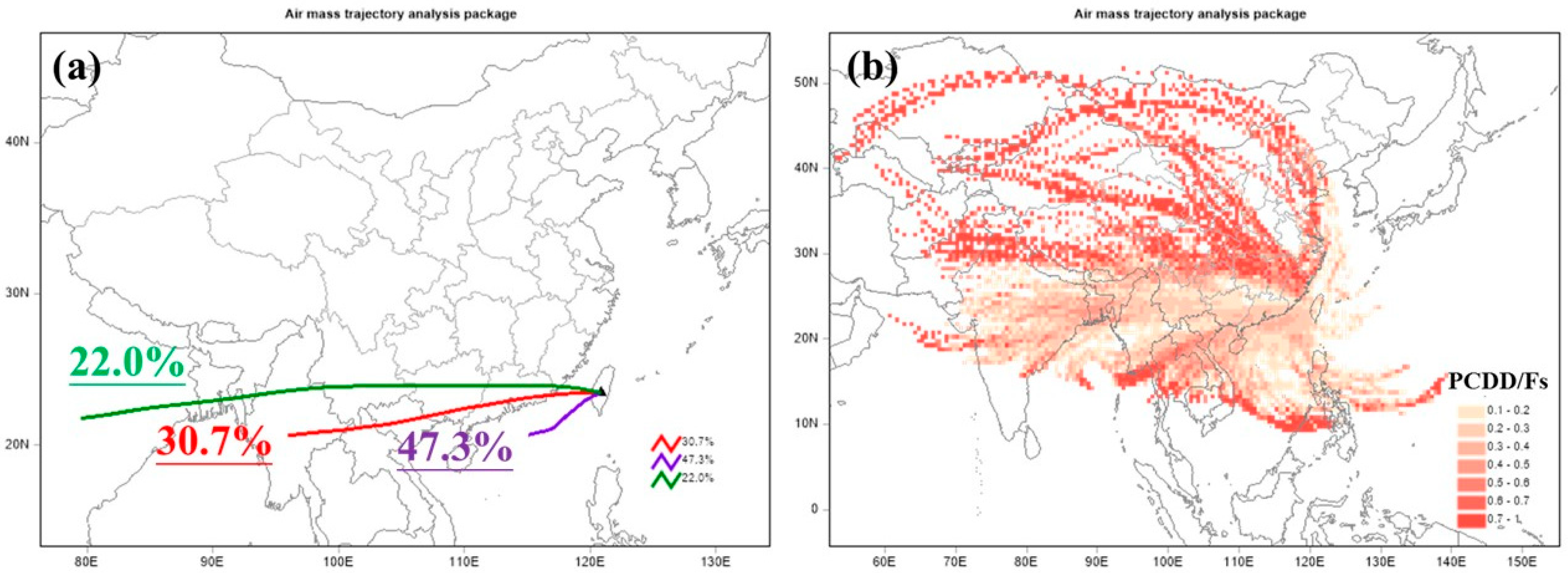The Long-Term Monitoring of Atmospheric Polychlorinated Dibenzo-p-Dioxin Dibenzofurans at a Background Station in Taiwan during Biomass Burning Seasons in El Niño and La Niña Events
Abstract
1. Introduction
2. Materials and Methods
2.1. The Information on the Sampling Site and Instrumentation
2.2. Analysis of Chemical Compounds
2.3. Source Apportionment
3. Results
3.1. The Measurement of WSIs during El Niño and La Niña
3.2. The Evaluation of Atmospheric PCDD/F Concentration in the Past Sixteen Years
3.3. Variation in Atmospheric PCDD/Fs Congener from 2007 to 2023
3.4. The Source Attribute Profile and Contribution of Atmospheric PCDD/Fs
4. Discussion
5. Conclusions
Supplementary Materials
Author Contributions
Funding
Institutional Review Board Statement
Informed Consent Statement
Data Availability Statement
Conflicts of Interest
References
- Boström, C.-E.; Gerde, P.; Hanberg, A.; Jernström, B.; Johansson, C.; Kyrklund, T.; Rannug, A.; Törnqvist, M.; Victorin, K.; Westerholm, R. Cancer risk assessment, indicators, and guidelines for polycyclic aromatic hydrocarbons in the ambient air. Environ. Health Perspect. 2002, 110, 451–488. [Google Scholar] [PubMed]
- Pope, C.A., III; Dockery, D.W. Health effects of fine particulate air pollution: Lines that connect. J. Air Waste Manag. Assoc. 2006, 56, 709–742. [Google Scholar] [CrossRef] [PubMed]
- Sitaras, I.E.; Siskos, P.A. The role of primary and secondary air pollutants in atmospheric pollution: Athens urban area as a case study. Environ. Chem. Lett. 2008, 6, 59–69. [Google Scholar] [CrossRef]
- Tomasi, C.; Lupi, A. Primary and secondary sources of atmospheric aerosol. In Atmospheric Aerosols: Life Cycles and Effects on Air Quality and Climate; John Wiley & Sons: Hoboken, NJ, USA, 2017; pp. 1–86. [Google Scholar]
- Needham, L.; Patterson, D., Jr.; Alley, C.; Isaacs, S.; Green, V.; Andrews, J.; Sampson, E.; Bagby, J. Polychlorinated Dibenzo-p-dioxins and Dibenzofurans Levels in Persons with High and Normal Levels of 2,3,7,8-tetrachlorodibenzo-p-dioxin. Chemosphere 1987, 16, 2027–2031. [Google Scholar] [CrossRef]
- Patterson, D., Jr.; Fingerhut, M.; Roberts, D.; Needham, L.; Sweeney, M.H.; Marlow, D.; Andrews, J., Jr.; Halperin, W. Levels of polychlorinated dibenzo-p-dioxins and dibenzofurans in workers exposed to 2,3,7,8-tetrachlorodibenzo-p-dioxin. Am. J. Ind. Med. 1989, 16, 135–146. [Google Scholar] [CrossRef]
- Mackay, D. Polynuckear aromatic hydrocarbon, polychlorinated Dioxins and Dibenzofurans. In Illustration Handbook of Physical-chemical Properties and Environmental Fate for Organic Chemicals; CRC Press: Boca Raton, FL, USA, 1992. [Google Scholar]
- Nisbet, I.C.; Lagoy, P.K. Toxic equivalency factors (TEFs) for polycyclic aromatic hydrocarbons (PAHs). Regul. Toxicol. Pharmacol. 1992, 16, 290–300. [Google Scholar] [CrossRef]
- Sulong, N.A.; Latif, M.T.; Sahani, M.; Khan, M.F.; Fadzil, M.F.; Tahir, N.M.; Mohamad, N.; Sakai, N.; Fujii, Y.; Othman, M. Distribution, sources and potential health risks of polycyclic aromatic hydrocarbons (PAHs) in PM2.5 collected during different monsoon seasons and haze episode in Kuala Lumpur. Chemosphere 2019, 219, 1–14. [Google Scholar] [CrossRef]
- Zhang, Q.; Huang, J.; Yu, G. Polychlorinated dibenzo-p-dioxins and dibenzofurans emissions from open burning of crop residues in China between 1997 and 2004. Environ. Pollut. 2008, 151, 39–46. [Google Scholar] [CrossRef]
- Chang, M.B.; Chang, S.H.; Chen, Y.W.; Hsu, H.C. Dioxin emission factors for automobiles from tunnel air sampling in Northern Taiwan. Sci. Total Environ. 2004, 325, 129–138. [Google Scholar] [CrossRef]
- Masuda, Y.; Schecter, A.; Päpke, O. Concentrations of PCBs, PCDFs and PCDDs in the blood of Yusho patients and their toxic equivalent contribution. Chemosphere 1998, 37, 1773–1780. [Google Scholar] [CrossRef]
- Tsai, Y.I.; Sopajaree, K.; Chotruksa, A.; Wu, H.-C.; Kuo, S.-C. Source indicators of biomass burning associated with inorganic salts and carboxylates in dry season ambient aerosol in Chiang Mai Basin, Thailand. Atmos. Environ. 2013, 78, 93–104. [Google Scholar] [CrossRef]
- Tsay, S.-C.; Hsu, N.C.; Lau, W.K.-M.; Li, C.; Gabriel, P.M.; Ji, Q.; Holben, B.N.; Welton, E.J.; Nguyen, A.X.; Janjai, S. From BASE-ASIA toward 7-SEAS: A satellite-surface perspective of boreal spring biomass-burning aerosols and clouds in Southeast Asia. Atmos. Environ. 2013, 78, 20–34. [Google Scholar] [CrossRef]
- Yadav, I.C.; Devi, N.L.; Li, J.; Syed, J.H.; Zhang, G.; Watanabe, H. Biomass burning in Indo-China peninsula and its impacts on regional air quality and global climate change—A review. Environ. Pollut. 2017, 227, 414–427. [Google Scholar] [CrossRef] [PubMed]
- Singh, A.; Chou, C.C.-K.; Chang, S.-Y.; Chang, S.-C.; Lin, N.-H.; Chuang, M.-T.; Pani, S.K.; Chi, K.H.; Huang, C.-H.; Lee, C.-T. Long-term (2003–2018) trends in aerosol chemical components at a high-altitude background station in the western North Pacific: Impact of long-range transport from continental Asia. Environ. Pollut. 2020, 265, 114813. [Google Scholar] [CrossRef] [PubMed]
- Ravindra Babu, S.; Ou-Yang, C.-F.; Griffith, S.M.; Pani, S.K.; Kong, S.S.-K.; Lin, N.-H. Transport pathways of carbon monoxide from Indonesian fire pollution to a subtropical high-altitude mountain site in the western North Pacific. Atmos. Chem. Phys. 2023, 23, 4727–4740. [Google Scholar] [CrossRef]
- Lee, C.-T.; Chuang, M.-T.; Lin, N.-H.; Wang, J.-L.; Sheu, G.-R.; Chang, S.-C.; Wang, S.-H.; Huang, H.; Chen, H.-W.; Liu, Y.-L. The enhancement of PM2.5 mass and water-soluble ions of biosmoke transported from Southeast Asia over the Mountain Lulin site in Taiwan. Atmos. Environ. 2011, 45, 5784–5794. [Google Scholar] [CrossRef]
- Hung, N.T.; Li, C.T.; Wang, S.H.; Ou-Yang, C.-F.; Lin, C.-Y.; Lee, C.-T.; Lin, N.-H.; Chi, K.H. Long-term monitoring of atmospheric PCDD/Fs at Mount Lulin during spring season: PCDD/F source apportionment through a simultaneous measurement in Southeast Asia. Chemosphere 2017, 185, 368–375. [Google Scholar] [CrossRef] [PubMed]
- Pani, S.K.; Lin, N.-H.; Lee, C.-T.; Griffith, S.M.; Chang, J.H.-W.; Hsu, B.-J. Insights into aerosol chemical composition and optical properties at Lulin Atmospheric Background Station (2862 m asl) during two contrasting seasons. Sci. Total Environ. 2022, 834, 155291. [Google Scholar] [CrossRef] [PubMed]
- Santoso, A.; Mcphaden, M.J.; Cai, W. The defining characteristics of ENSO extremes and the strong 2015/2016 El Niño. Rev. Geophys. 2017, 55, 1079–1129. [Google Scholar] [CrossRef]
- Hu, S.; Fedorov, A.V. The extreme El Niño of 2015–2016: The role of westerly and easterly wind bursts, and preconditioning by the failed 2014 event. Clim. Dyn. 2019, 52, 7339–7357. [Google Scholar] [CrossRef]
- Aragão, L.E.; Anderson, L.O.; Fonseca, M.G.; Rosan, T.M.; Vedovato, L.B.; Wagner, F.H.; Silva, C.V.; Junior, C.H.S.; Arai, E.; Aguiar, A.P. 21st Century drought-related fires counteract the decline of Amazon deforestation carbon emissions. Nat. Commun. 2018, 9, 536. [Google Scholar] [CrossRef]
- Field, R.D.; Van Der Werf, G.R.; Fanin, T.; Fetzer, E.J.; Fuller, R.; Jethva, H.; Levy, R.; Livesey, N.J.; Luo, M.; Torres, O. Indonesian fire activity and smoke pollution in 2015 show persistent nonlinear sensitivity to El Niño-induced drought. Proc. Natl. Acad. Sci. USA 2016, 113, 9204–9209. [Google Scholar] [CrossRef]
- Van Der Werf, G.R.; Randerson, J.T.; Giglio, L.; Van Leeuwen, T.T.; Chen, Y.; Rogers, B.M.; Mu, M.; Van Marle, M.J.; Morton, D.C.; Collatz, G.J. Global fire emissions estimates during 1997–2016. Earth Syst. Sci. Data 2017, 9, 697–720. [Google Scholar] [CrossRef]
- Nguyen, L.S.P.; Nguyen, K.T.; Griffith, S.M.; Sheu, G.-R.; Yen, M.-C.; Chang, S.-C.; Lin, N.-H. Multiscale temporal variations of atmospheric mercury distinguished by the Hilbert–Huang transform analysis reveals multiple El Niño–southern Oscillation Links. Environ. Sci. Technol. 2021, 56, 1423–1432. [Google Scholar] [CrossRef] [PubMed]
- Cataldo, D.; Leites, V.; Bordet, F.; Paolucci, E. Effects of El Niño-Southern Oscillation (ENSO) on the reproduction of migratory fishes in a large South American reservoir. Hydrobiologia 2022, 849, 3259–3274. [Google Scholar] [CrossRef]
- Kraisitnitikul, P.; Thepnuan, D.; Chansuebsri, S.; Yabueng, N.; Wiriya, W.; Saksakulkrai, S.; Shi, Z.; Chantara, S. Contrasting compositions of PM2.5 in northern Thailand during La niña (2017) and El niño (2019) years. J. Environ. Sci. 2024, 135, 585–599. [Google Scholar] [CrossRef] [PubMed]
- Kampa, M.; Castanas, E. Human health effects of air pollution. Environ. Pollut. 2008, 151, 362–367. [Google Scholar] [CrossRef]
- Tomašek, I.; Damby, D.E.; Andronico, D.; Baxter, P.J.; Boonen, I.; Claeys, P.; Denison, M.S.; Horwell, C.J.; Kervyn, M.; Kueppers, U. Assessing the biological reactivity of organic compounds on volcanic ash: Implications for human health hazard. Bull. Volcanol. 2021, 83, 30. [Google Scholar] [CrossRef]
- Punsompong, P.; Pani, S.K.; Wang, S.-H.; Pham, T.T.B. Assessment of biomass-burning types and transport over Thailand and the associated health risks. Atmos. Environ. 2021, 247, 118176. [Google Scholar] [CrossRef]
- Fadel, M.; Ledoux, F.; Afif, C.; Courcot, D. Human health risk assessment for PAHs, phthalates, elements, PCDD/Fs, and DL-PCBs in PM2.5 and for NMVOCs in two East-Mediterranean urban sites under industrial influence. Atmos. Pollut. Res. 2022, 13, 101261. [Google Scholar] [CrossRef]
- Ting, Y.-C.; Ku, C.-H.; Zou, Y.-X.; Chi, K.-H.; Soo, J.-C.; Hsu, C.-Y.; Chen, Y.-C. Characteristics and source-specific health risks of ambient PM2.5-bound PAHs in an urban city of northern Taiwan. Aerosol Air Qual. Res. 2023, 23. [Google Scholar] [CrossRef]
- Ngo, T.H.; Yang, Y.-H.; Chen, Y.-C.; Pan, W.C.; Chi, K.H. Continuous nationwide atmospheric PCDD/F monitoring network in Taiwan (2006–2016): Variation in concentrations and apportionment of emission sources. Chemosphere 2020, 255, 126979. [Google Scholar] [CrossRef]
- Chi, K.H.; Hsu, S.C.; Wang, S.H.; Chang, M.B. Increases in ambient PCDD/F and PCB concentrations in Northern Taiwan during an Asian dust storm episode. Sci. Total Environ. 2008, 401, 100–108. [Google Scholar] [CrossRef] [PubMed]
- Pan, S.Y.; Chen, H.W.; Hsu, S.C.; Chou, C.C.-K.; Lin, Y.C.; Chen, Y.W.; Chi, K.H. Assessment of Atmospheric PM2.5 and PCDD/Fs Collected by Different High-volume Ambient Air Sampling Systems. Aerosol Air Qual. Res. 2022, 22, 220116. [Google Scholar] [CrossRef]
- Chen, W.-R.; Singh, A.; Pani, S.K.; Chang, S.-Y.; Chou, C.C.-K.; Chang, S.-C.; Chuang, M.-T.; Lin, N.-H.; Huang, C.-H.; Lee, C.-T. Real-time measurements of PM2.5 water-soluble inorganic ions at a high-altitude mountain site in the western North Pacific: Impact of upslope wind and long-range transported biomass-burning smoke. Atmos. Res. 2021, 260, 105686. [Google Scholar] [CrossRef]
- Hsu, C.-Y.; Chiang, H.-C.; Lin, S.-L.; Chen, M.-J.; Lin, T.-Y.; Chen, Y.-C. Elemental characterization and source apportionment of PM10 and PM2.5 in the western coastal area of central Taiwan. Sci. Total Environ. 2016, 541, 1139–1150. [Google Scholar] [CrossRef] [PubMed]
- Maleki, R.; Asadgol, Z.; Kermani, M.; Jafari, A.J.; Arfaeinia, H.; Ghodsi, S.; Gholami, M. Concentration, sources, and inhalation-based risk assessment of PM2.5-bound PAHs and trace elements in ambient air of areas with low and high traffic density in Tehran. Arab. J. Geosci. 2021, 14, 855. [Google Scholar] [CrossRef]
- Callén, M.S.; Iturmendi, A.; López, J.M. Source apportionment of atmospheric PM2.5-bound polycyclic aromatic hydrocarbons by a PMF receptor model. Assessment of potential risk for human health. Environ. Pollut. 2014, 195, 167–177. [Google Scholar] [CrossRef]
- Paatero, P.; Tapper, U. Positive matrix factorization: A non-negative factor model with optimal utilization of error estimates of data values. Environmetrics 1994, 5, 111–126. [Google Scholar] [CrossRef]
- Ashbaugh, L.L.; Malm, W.C.; Sadeh, W.Z. A residence time probability analysis of sulfur concentrations at Grand Canyon National Park. Atmos. Environ. 1985, 19, 1263–1270. [Google Scholar] [CrossRef]
- Malm, W.; Johnson, C.; Bresch, J. Application of principal component analysis for purposes of identifying source-receptor relationships. Recept. Methods Source Apportionment 1986, 127, 148. [Google Scholar]
- Chang, S.-S.; Lee, W.-J.; Holsen, T.M.; Li, H.-W.; Wang, L.-C.; Chang-Chien, G.-P. Emissions of polychlorinated-p-dibenzo dioxin, dibenzofurans (PCDD/Fs) and polybrominated diphenyl ethers (PBDEs) from rice straw biomass burning. Atmos. Environ. 2014, 94, 573–581. [Google Scholar] [CrossRef]
- Rogge, W.F.; Hildemann, L.M.; Mazurek, M.A.; Cass, G.R.; Simoneit, B.R. Sources of fine organic aerosol. 3. Road dust, tire debris, and organometallic brake lining dust: Roads as sources and sinks. Environ. Sci. Technol. 1993, 27, 1892–1904. [Google Scholar] [CrossRef]
- Querol, X.; Alastuey, A.; Rodriguez, S.; Plana, F.; Mantilla, E.; Ruiz, C.R. Monitoring of PM10 and PM2.5 around primary particulate anthropogenic emission sources. Atmos. Environ. 2001, 35, 845–858. [Google Scholar] [CrossRef]
- Chi, K.H.; Lin, C.-Y.; Yang, C.-F.O.; Wang, J.-L.; Lin, N.-H.; Sheu, G.-R.; Lee, C.-T. PCDD/F measurement at a high-altitude station in Central Taiwan: Evaluation of long-range transport of PCDD/Fs during the Southeast Asia biomass burning event. Environ. Sci. Technol. 2010, 44, 2954–2960. [Google Scholar] [CrossRef]
- Hsueh, Y.-H.; Li, K.-F.; Lin, L.-C.; Bhattacharya, S.K.; Laskar, A.H.; Liang, M.-C. East Asian CO2 level change caused by Pacific decadal oscillation. Remote Sens. Environ. 2021, 264, 112624. [Google Scholar] [CrossRef]
- Ngo, T.H.; Hsu, W.T.; Chi, K.H. Evaluation of the relative health risk impact of atmospheric PCDD/Fs in PM2.5 in Taiwan. Aerosol Air Qual. Res 2018, 18, 2591–2599. [Google Scholar]
- Ngo, T.H.; Hien, T.T.; Thuan, N.T.; Minh, N.H.; Chi, K.H. Atmospheric PCDD/F concentration and source apportionment in typical rural, Agent Orange hotspots, and industrial areas in Vietnam. Chemosphere 2017, 182, 647–655. [Google Scholar] [CrossRef]
- Janta, R.; Sekiguchi, K.; Yamaguchi, R.; Sopajaree, K.; Pongpiachan, S.; Chetiyanukornkul, T. Ambient PM2.5, polycyclic aromatic hydrocarbons and biomass burning tracer in Mae Sot District, western Thailand. Atmos. Pollut. Res. 2020, 11, 27–39. [Google Scholar] [CrossRef]





Disclaimer/Publisher’s Note: The statements, opinions and data contained in all publications are solely those of the individual author(s) and contributor(s) and not of MDPI and/or the editor(s). MDPI and/or the editor(s) disclaim responsibility for any injury to people or property resulting from any ideas, methods, instructions or products referred to in the content. |
© 2024 by the authors. Licensee MDPI, Basel, Switzerland. This article is an open access article distributed under the terms and conditions of the Creative Commons Attribution (CC BY) license (https://creativecommons.org/licenses/by/4.0/).
Share and Cite
Pan, S.Y.; Hsu, Y.-S.; Hsu, Y.C.; Ngo, T.H.; Chou, C.C.-K.; Lin, N.-H.; Chi, K.H. The Long-Term Monitoring of Atmospheric Polychlorinated Dibenzo-p-Dioxin Dibenzofurans at a Background Station in Taiwan during Biomass Burning Seasons in El Niño and La Niña Events. Atmosphere 2024, 15, 1002. https://doi.org/10.3390/atmos15081002
Pan SY, Hsu Y-S, Hsu YC, Ngo TH, Chou CC-K, Lin N-H, Chi KH. The Long-Term Monitoring of Atmospheric Polychlorinated Dibenzo-p-Dioxin Dibenzofurans at a Background Station in Taiwan during Biomass Burning Seasons in El Niño and La Niña Events. Atmosphere. 2024; 15(8):1002. https://doi.org/10.3390/atmos15081002
Chicago/Turabian StylePan, Shih Yu, Yen-Shun Hsu, Yuan Cheng Hsu, Tuan Hung Ngo, Charles C.-K. Chou, Neng-Huei Lin, and Kai Hsien Chi. 2024. "The Long-Term Monitoring of Atmospheric Polychlorinated Dibenzo-p-Dioxin Dibenzofurans at a Background Station in Taiwan during Biomass Burning Seasons in El Niño and La Niña Events" Atmosphere 15, no. 8: 1002. https://doi.org/10.3390/atmos15081002
APA StylePan, S. Y., Hsu, Y.-S., Hsu, Y. C., Ngo, T. H., Chou, C. C.-K., Lin, N.-H., & Chi, K. H. (2024). The Long-Term Monitoring of Atmospheric Polychlorinated Dibenzo-p-Dioxin Dibenzofurans at a Background Station in Taiwan during Biomass Burning Seasons in El Niño and La Niña Events. Atmosphere, 15(8), 1002. https://doi.org/10.3390/atmos15081002






